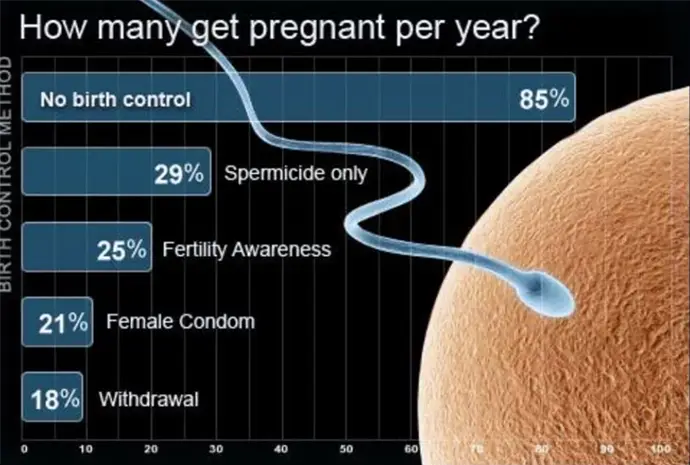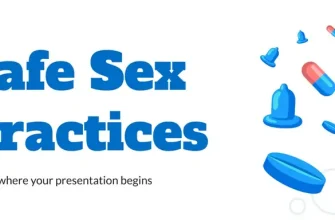Sexuality is an integral part of human life that encompasses a wide range of behaviors, expressions, and identities. Despite its importance, sex remains a topic shrouded in myths and misconceptions. These false beliefs can lead to misinformation, unhealthy practices, and unnecessary anxiety, affecting individuals’ physical and emotional well-being. This article aims to debunk common sex myths by providing factual information, statistics, and references to reliable sources. By doing so, we hope to promote a better understanding of sexual health and encourage open, informed discussions.
Myth 1: You Can’t Get Pregnant During Your Period

Contrary to popular belief, it is possible to become pregnant during menstruation. While the likelihood is lower compared to other times in the menstrual cycle, the risk is not zero. Sperm can survive inside the female reproductive tract for up to five days under optimal conditions. If a woman has a shorter menstrual cycle, ovulation can occur soon after her period ends. In such cases, sperm from intercourse during menstruation can remain viable and fertilize an egg released during early ovulation.
Explanation:
The menstrual cycle is often misunderstood. A typical cycle lasts about 28 days, but normal cycles can range from 21 to 35 days in adults. Ovulation usually occurs around the middle of the cycle, but this can vary greatly among individuals and even from month to month for the same person. Factors such as stress, illness, and hormonal imbalances can affect the timing of ovulation.
Furthermore, menstrual bleeding can be mistaken for other types of vaginal bleeding, such as ovulation spotting. Without accurate tracking, it can be challenging to determine the exact phase of the menstrual cycle.
Statistics:
- According to the American College of Obstetricians and Gynecologists (ACOG), menstrual cycles can vary significantly, affecting ovulation timing. Studies have shown that approximately 20% of women have irregular cycles, increasing the unpredictability of ovulation.[1]
Implications:
Relying on the assumption that menstruation is a “safe” period can lead to unintended pregnancies. It’s essential for sexually active individuals to use reliable contraception consistently, regardless of the menstrual phase.
Myth 2: Men Always Want Sex

The stereotype that men have an insatiable desire for sex is misleading and can be harmful. Sexual desire varies widely among individuals, regardless of gender. Numerous factors influence libido, including physical health, mental well-being, stress levels, hormonal fluctuations, medication side effects, and the quality of personal relationships.
Explanation:
Cultural and societal expectations often pressure men to conform to the idea that they should always be ready and eager for sexual activity. This can lead to feelings of inadequacy, shame, or confusion when they experience low desire. Recognizing that it’s normal for men to have fluctuating libido is important for mental health and fostering honest communication in relationships.
Statistics:
- A study published in the Journal of the American Medical Association found that approximately 15% of men aged 18 to 59 reported a lack of interest in sex lasting at least several months in the previous year. [2]
- Another study indicated that about 14% of men experience sexual desire disorders at some point in their lives.
Implications:
Understanding that men can experience low sexual desire emphasizes the need for empathy and open dialogue between partners. It also highlights the importance of addressing underlying issues such as depression, anxiety, or medical conditions that may affect libido.
Myth 3: Women Don’t Watch Pornography

The notion that pornography is exclusively a male interest is outdated and incorrect. Women do consume adult content for various reasons, including sexual arousal, education, and exploration of fantasies. Ignoring this fact perpetuates stereotypes about female sexuality and can inhibit open conversations about sexual preferences and desires.
Explanation:
Societal taboos and gender norms have historically discouraged women from openly expressing their sexuality or admitting to consuming erotic materials. However, with the rise of the internet and increased accessibility, more women are engaging with adult content. This shift reflects a broader movement towards sexual empowerment and autonomy among women.
Statistics:
- Research by the Kinsey Institute indicates that approximately 33% of women view pornography regularly, challenging the misconception that it’s predominantly a male activity. [3]
- A study published in the Journal of Sex Research found that 85% of women have viewed pornography at some point in their lives.
Implications:
Recognizing that women also consume adult content can lead to more inclusive discussions about sexual health and preferences. It underscores the importance of creating adult content that caters to diverse audiences and promotes positive representations of sexuality.
Myth 4: Condoms Reduce Pleasure Significantly

While some people believe that condoms diminish sexual pleasure, modern condom designs aim to enhance sensitivity and enjoyment. Moreover, the protection condoms provide against sexually transmitted infections (STIs) and unintended pregnancies far outweighs any minimal reduction in sensation.
Explanation:
Advancements in condom technology have led to the development of ultra-thin, textured, and lubricated condoms that can increase pleasure for both partners. Psychological factors also play a role; believing that condoms reduce pleasure can influence one’s perception of the experience.
Additionally, the peace of mind that comes from practicing safer sex can enhance overall satisfaction by reducing anxiety about potential health risks.
Statistics:
- A study in the Journal of Sexual Medicine reported that both men and women rated sexual experiences with condoms as highly arousing and pleasurable. [4]
- Another study found that 77% of men and 82% of women reported high levels of sexual enjoyment when using condoms.
Implications:
Dispelling this myth encourages safer sex practices. Educating individuals about the variety of condoms available can help them find options that suit their preferences, thereby maintaining pleasure while ensuring protection.
Myth 5: The Withdrawal Method Is an Effective Form of Birth Control

The withdrawal method, also known as “pulling out,” is unreliable due to the presence of sperm in pre-ejaculate fluid and the challenges associated with timing withdrawal correctly. It offers no protection against STIs.
Explanation:
Pre-ejaculate fluid can contain sperm from a previous ejaculation if the man has not urinated since. Moreover, withdrawing before ejaculation requires significant self-control and timing, which can be affected by various factors such as intoxication or heightened arousal.
Statistics:
- Planned Parenthood notes that with typical use, the withdrawal method has a failure rate of about 22%. This means that 22 out of 100 women relying on this method may become pregnant within a year. [5]
- In contrast, condoms have a typical use failure rate of about 13%, and hormonal contraceptives like the pill have a failure rate of about 7%.
Implications:
Relying solely on the withdrawal method increases the risk of unintended pregnancy. Couples should consider more reliable forms of contraception and discuss options with a healthcare provider to choose a method that fits their needs.
Myth 6: You Can Tell If Someone Has an STI

Many sexually transmitted infections are asymptomatic, meaning they show no visible signs or symptoms. Relying on visual cues or assuming someone is STI-free based on appearance is risky and can lead to the spread of infections.
Explanation:
Infections like chlamydia, human papillomavirus (HPV), and herpes simplex virus can remain dormant or cause mild symptoms that go unnoticed. Individuals may unknowingly transmit STIs to their partners.
Regular testing is crucial, especially for sexually active individuals with multiple partners. Open communication about sexual health status and history is also important.
Statistics:
- The Centers for Disease Control and Prevention (CDC) reports that 1 in 5 people in the U.S. have an STI, with many unaware of their infection. [6]
- Approximately 70% of women and 50% of men with chlamydia are asymptomatic.
Implications:
Practicing safe sex, including the use of condoms and regular STI screenings, is essential. Educating people about the asymptomatic nature of many STIs can help reduce stigma and encourage proactive health measures.
Myth 7: Older Adults Don’t Have Sex

Sexual activity can continue well into older age, contributing positively to overall health, intimacy, and quality of life. Age does not inherently diminish sexual desire or the ability to enjoy sex.
Explanation:
Physical changes associated with aging can affect sexual function, such as decreased lubrication in women or erectile dysfunction in men. However, many of these issues can be addressed with medical assistance, lifestyle changes, or the use of sexual aids.
Emotional intimacy, companionship, and the expression of affection remain important throughout life. Sexuality in older adults may focus more on these aspects rather than solely on physical performance.
Statistics:
- A study from the New England Journal of Medicine found that over 50% of adults aged 65-74 are sexually active, with about 26% remaining active between 75-85 years old. [7]
- The same study reported that sexual activity is linked to better health and longevity among older adults.
Implications:
Acknowledging that older adults are sexually active can improve healthcare by encouraging discussions about sexual health, STI prevention, and addressing sexual dysfunction. It also helps combat ageism and promotes a more inclusive understanding of sexuality.
Dispelling these myths is essential for promoting sexual health, reducing stigma, and empowering individuals to make informed decisions. Education and open communication are key to fostering a culture that respects and understands the complexities of human sexuality. By relying on accurate information and challenging misconceptions, we can enhance personal relationships, improve public health outcomes, and support the well-being of individuals across all ages.
References:
- American College of Obstetricians and Gynecologists. (2020). Your Menstrual Cycle
- Laumann, E. O., et al. (1999). Sexual Dysfunction in the United States: Prevalence and Predictors. JAMA, 281(6), 537-544.
- The Kinsey Institute. (2018). Women’s Sexual Behaviors: Pornography Use
- Sanders, S. A., & Reece, M. (2010). Sexual Satisfaction and the Importance of Sexual Health to Quality of Life Among University Students. Journal of Sexual Medicine, 7(5), 2131-2140.
- Planned Parenthood. (2021). Withdrawal (Pull Out Method)
- Centers for Disease Control and Prevention. (2021). STDs in the United States https://www.cdc.gov/std/statistics/default.htm
- Lindau, S. T., et al. (2007). A Study of Sexuality and Health among Older Adults in the United States. New England Journal of Medicine, 357(8), 762-774.

Gerald Werner
Sex Education Editor
An experienced editor with a background in journalism and a master’s degree in education, they lead the Sex Education section at EroticThreads. With over 15 years of experience in writing and editorial management, they have contributed to expanding the platform’s reach and impact by creating evidence-based, inclusive, and engaging content on sexual wellness, relationships, and personal empowerment. Their work has been featured in several international forums and publications advocating for modernized sexual education. Outside of their professional role, they enjoy exploring the outdoors, experimenting with vegan cuisine, and curating a personal library of rare and first-edition books.








